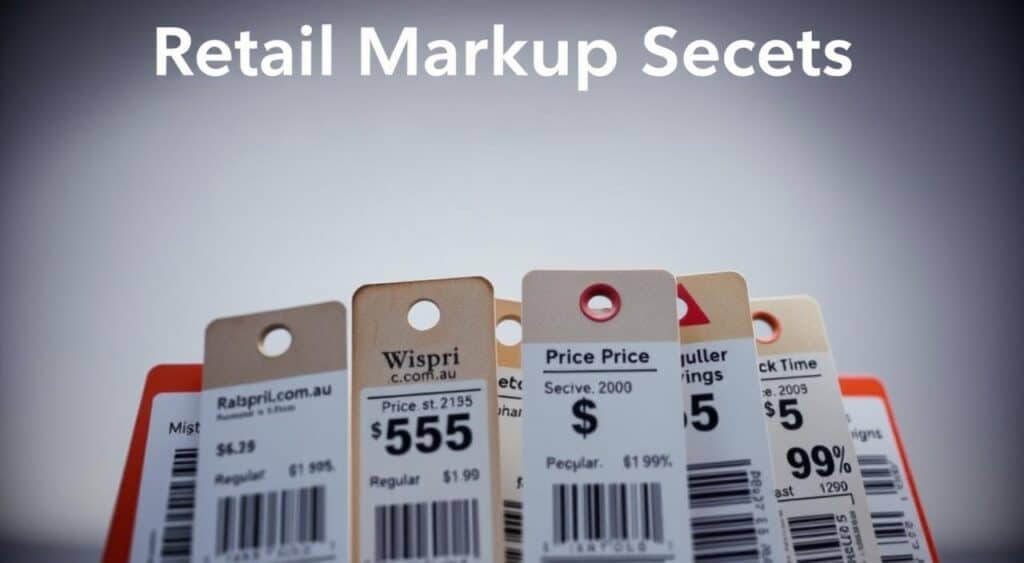Ever wondered why that $89 jumper feels overpriced? Or why some “discounts” aren’t what they seem? In Australia, shoppers lose an average of $1,200 yearly by missing ideal purchase timing, while 73% of online “sales” don’t actually cut prices. The truth? Understanding how businesses set prices changes everything.
Price tags reflect more than just product costs. They include staff wages, rent, marketing, and competition from global online stores. Local retailers juggle transport expenses and smaller markets too. This creates layered pricing strategies that affect what you pay at JB Hi-Fi, Harvey Norman, or Amazon Australia.
Markups aren’t random. They’re calculated using demand, trends, and profit goals. For example, a 50% markup on a $50 wholesale item becomes $75 retail. But during sales, claimed “huge discounts” often just trim margins rather than offering real value.
Tools like Wispri cut through the noise. By tracking price histories across Aussie stores, their AI alerts you when items hit your target. This helps you spot genuine bargains and avoid fake promotions. Knowing markup principles turns you into a savvy shopper – ready to negotiate, time purchases, and save smarter.
Key Takeaways
- Multiple factors shape pricing, including transport costs and local market size
- Markups cover business expenses beyond product acquisition
- Timing purchases using data helps avoid inflated prices
- Technology reveals true discounts versus marketing hype
- Understanding margins improves negotiation power
Understanding Retail Markup in Australia
What really goes into the price tag of your favourite products? That $75 drill at Bunnings or $199 monitor at Officeworks reflects careful calculations. Let’s break down how businesses balance costs and profits in our local market.
Defining Retail Markup for Australian Shoppers
Markup works like this: (Selling Price – Wholesale Cost) ÷ Cost × 100. If Harvey Norman buys headphones for $80 and sells them for $120, that’s a 50% markup. This covers everything from warehouse fees to staff wages.

| Retailer | Product | Wholesale Cost | Selling Price | Markup |
|---|---|---|---|---|
| Bunnings | Cordless Drill | $50 | $75 | 50% |
| JB Hi-Fi | Bluetooth Speaker | $35 | $52.50 | 50% |
| Amazon AU | Smartwatch | $120 | $168 | 40% |
Influences on Retail Pricing Strategies
Three key factors shape Aussie prices:
- Location matters: Rural stores often add 10-15% extra for transport costs
- Import battles: A weak Aussie dollar can push electronics markups up 20%
- Seasonal swings: EOFY sales might cut markups by 30% to clear stock
Wispri’s tracking reveals patterns across 15+ retailers. Their data shows Officeworks often adjusts printer prices weekly, while eBay sellers change markups daily. This helps you spot when that “special offer” at Kogan is genuinely better than Amazon’s deal.
Retail Markup Secrets
Ever questioned why two stores charge wildly different prices for the same toaster? The answer lies in hidden pricing tactics that shape your shopping experience. Let’s uncover the methods businesses use to balance their ledgers while keeping customers none the wiser.

Why Knowing Markup is Essential
Most Aussie stores use keystone pricing – doubling wholesale costs instantly. That $30 power bank becomes $60 retail before you blink. But here’s the kicker: many create fake “RRP” labels to make standard prices seem discounted.
Seasonal tricks catch many shoppers off guard. Retailers quietly boost markups 20% before Christmas sales, then “discount” items to original prices. Wispri’s data shows Kogan often does this with electronics, while Myer adjusts homeware margins seasonally.
Common Misconceptions in Markup Calculation
Three myths busted:
- Myth 1: “Sale prices mean low profit.” Truth? Most promotions still keep 50%+ margins
- Myth 2: “$49.95 means better value.” It’s just psychology – the markup percentage stays identical
- Myth 3: “All stores have similar costs.” Amazon AU often undercuts Harvey Norman by 15% on identical items
This is where tools like Wispri become game-changers. Their AI tracks real cost histories across 20+ Aussie retailers. When Officeworks lists a “discounted” printer, you’ll know if it’s genuinely below average market price – not just a marketing ploy.
Smart shoppers check multiple outlets. That Dyson fan might have 80% markup at Bing Lee but only 55% at The Good Guys. Knowledge turns you into a bargain-hunting ninja, saving hundreds annually on tech, appliances, and seasonal purchases.
How Wispri Revolutionises Price Tracking
What if you could see through pricing tricks like a pro? Wispri’s tools turn complex margin calculations into clear shopping strategies. By analysing live market data across Australia’s top stores, it helps you spot genuine deals versus marketing fluff.
![]()
AI-Powered Price Monitoring Benefits
Wispri’s brainy tech tracks 25+ retailers daily. It spots patterns like JB Hi-Fi lowering speaker markups every 6 weeks or Amazon AU adjusting smartwatch prices hourly. This means you get alerts when true value emerges, not just random sales.
| Feature | Manual Tracking | Wispri AI |
|---|---|---|
| Price History Analysis | 3-hour research | Instant reports |
| Pattern Recognition | Missed trends | Cyclical alerts |
| Alert Speed | Days late | Real-time updates |
Customisable Price Drop Alerts for Smart Purchases
Set your perfect price target and relax. When Bunnings trims drill margins or Officeworks slashes printer costs, Wispri pings you. One user saved $412 on a fridge by catching a 22% markdown Harvey Norman hid in midnight updates.
The PRO version digs deeper, showing how eBay sellers shift profit margins during tax time. You’ll know if that “50% off” TV at Kogan really beats Amazon’s usual pricing. No more guessing games – just cold, hard data-driven decisions.
Techniques to Calculate Markup and Margin
Cracking the code behind price tags starts with simple maths. Whether you’re comparing appliances at JB Hi-Fi or tech at Officeworks, knowing how businesses set numbers helps you spot fair deals. Let’s break down the essentials every Aussie shopper needs.
Step-by-Step Markup Calculation Examples
Imagine Kmart buys beach towels for $12 each. Using a 60% markup percentage, the selling price becomes $19.20. Here’s how: ($12 × 1.6) = $19.20. This covers transport, staff costs, and still leaves room for sales discounts later.
Margin vs Markup: Key Differences and Applications
While markup builds prices from costs, margin shows profit per dollar earned. A $50 item sold for $75 has a 50% markup but 33% profit margin. Stores like Harvey Norman use margin to track overall success, while markup shapes daily pricing strategies.
Tools like Wispri simplify these calculations. Their dashboards show real-time profit margins across stores, so you know when that “half-price” TV at The Good Guys truly beats Amazon’s offer. Master these basics, and you’ll outsmart seasonal tricks while keeping more cash in your pocket.

